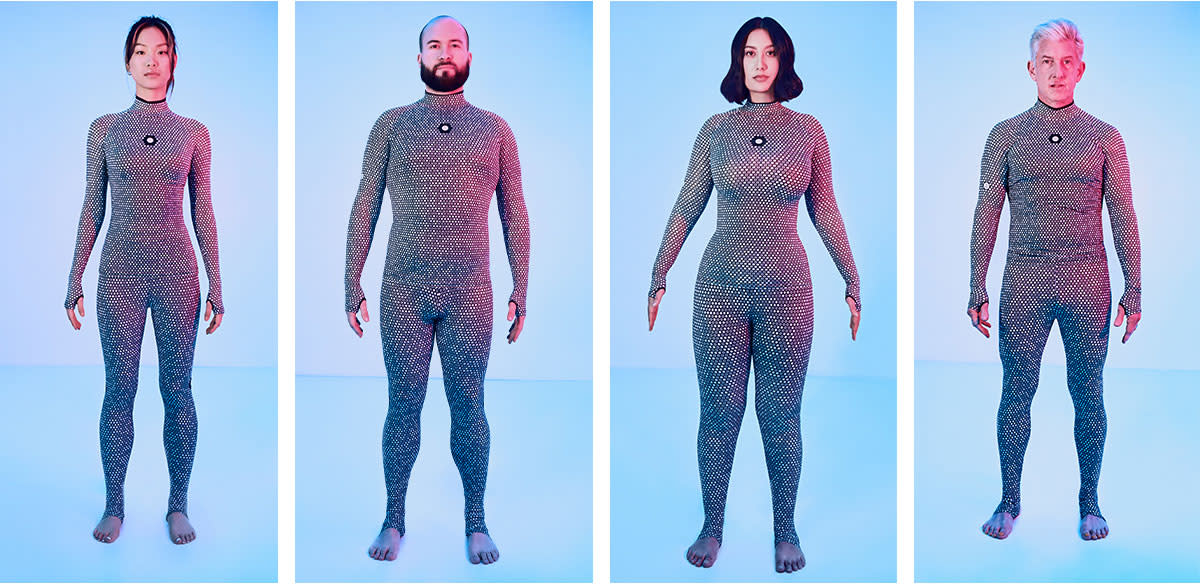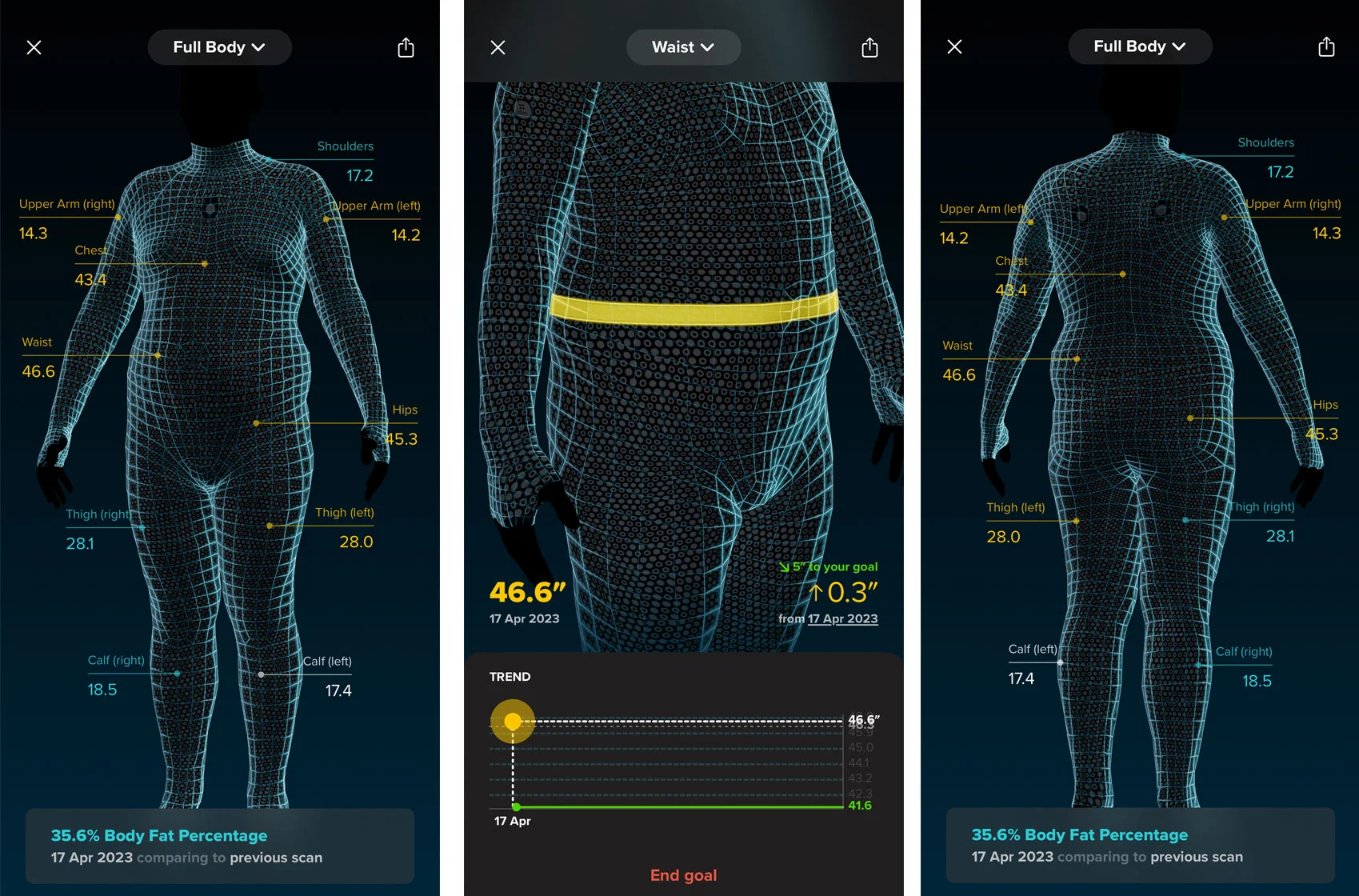
I’ve developed an odd fascination with body-measuring technology, especially as it relates to the fashion world. Many companies are working on infrastructure that will hopefully one day let us buy clothes custom-tailored for the exact contours of our bodies. That should make people like me, who feel very under-served by the traditional fashion industry, a lot happier. It should also help to reduce the waste generated by the overproduction of clothes nobody wants to buy, which is a problem both for businesses and the planet. So, when Zozofit, makers of the Zozosuit, asked if I wanted to try its skin-tight body-measuring outfit, which has now been repurposed as a fitness tool, I agreed, albeit with my usual degree of trepidation.
The Zozosuit isn’t new, but its makers are using this year as a form of soft relaunch, with a new focus on breaking into the US. It was actually set up back in 2018 by Japanese high-end fashion retailer Zozo as a way of launching a custom-clothing line. Users bought the suit, scanned their bodies and then could order clothes that, on paper, were tailored to better suit their bodies. And while the clothes weren’t custom-made, the idea was that the outfits would be a better fit for them than the usual mass-produced stuff. But that idea, great in theory, didn’t necessarily shake out that well in practice.
Fashion Network said that the cost and complexity involved in launching the suit ate away at the company’s otherwise healthy profits. QZ reported that while people bought the suits, which were sold at a deep discount, few went on to purchase the custom threads as Zozo had planned. It got worse, as many reporters who tested the system found the clothes they had ordered, like Gizmodo’s Ryan F. Mandelbaum and the Economist’s Charlie Wells, didn’t actually fit. A better suit with higher-resolution dots for imaging was developed, but the project was subsequently put on ice.
Since then, Zozo has tried to open up its technology to third parties, but has now pivoted the technology toward something more fitness-focused. Since it already had the tech to make a body-measuring suit, it might as well be put to good use, or so the thinking goes. A number of health and fitness professionals advocate that, for people looking to get fitter, measure their bodies instead of stepping on the scale. So it makes sense for this to be offered as an elegant alternative to wrestling with a tape measure on a weekly basis.
Buying a Zozosuit is easy enough, just give it your weight in pounds, as well as your height in feet and inches, and cough up $98 plus tax. Not long after, you’ll get a slender package which contains a skinsuit made out of polyester and spandex. It looks very much like a motion capture suit commonly used in the production of visual effects, and functionally does the same job. Coming in two parts, the app will give you guidance on how to wear it, making sure that the waistband is pulled up high and covered by the top. You’ll need to try and keep everything as flat as you can, since visible creases will prevent you from taking an accurate scan.
Zozofit
As a 5’11”, 231-pound man, I did wonder if Zozo would have a suit large enough to cater for my body shape. The website has images of much more athletically-adept models wearing its clothing and you may be concerned there’s no option for bigger-sized folks. The suit I tried on was tight, as intended, but didn’t feel restrictive, and I don’t think you should be nervous that the company can’t accommodate your needs. Other users in a similar situation have documented a similar experience, including YouTuber The Fabric Ninja, who produced a “Plus-Size Review” in 2020. That said, I don’t think I could pull this off as some form of athleisure fashion statement, for all of the reasons you can probably presume.
Inside the package is a cardboard phone stand, which you’ll need to pop out and fold into place to prop your smartphone onto. The Zozofit uses your handset’s primary camera, and so you’ll need to stand it on a table and then stand six feet or so away from it. Once activated, you’ll get voice guidance talking you through the setup and measurement process, and you’ll be asked to hold your arms slightly away from your body. The coach will then ask you to turn to every position on the clock, taking 12 images as you shuffle around in a circle. Once completed, you’ll be notified that you can pick up your phone and then wait 30 seconds-or-so for the model to process.
And you’ll get a headless 3D-mesh model of your body with various measurements labeled off the sides. These include measurements for your upper arms, chest, waist and hips, upper thigh and your calves. After you’ve pawed at your vital statistics, you’ll be invited to set some fitness goals based on those initial measurements. Interestingly, these are capped, I suspect to keep you picking smaller, more sustainable goals and avoid becoming disappointed. It measured my waist at 46.6-inches, and you can only set the goal at inch-wide increments down to 41.6-inches or up to 51.6-inches. This will change in a later update, but I appreciated the more realistic form of goal-setting it promises.
You’ll also get the app’s rough calculation of your body fat percentage, which it clocked at 35.6 percent. Not long after, I jumped on my smart scale and it registered me as having 31.6 percent, and I suspect, too, the imaging might struggle to be as accurate when you’re dealing with such big figures. I’d wager, too, that body fat percentages might not be so easily calculated by sight alone, and perhaps Zozo could look to remove those measurements which aren’t as reliable. It may also dent the PR braggadocio the company is putting out, claiming that this setup is the “world’s most accurate at-home 3D body scanner.” (It says it has compared its results to several rivals on the market, as well as professional hand-measurements.)

Zozofit / Daniel Cooper
Now, the company says that its body fat measurements use the US Navy Body Fat system, which calculates your body fat based on a series of body measurements. That method was developed to create a quick-and-dirty measurement to determine if someone was fit for service. (In the process of researching this, I learned that personnel describe it as the “rope and choke,” which isn’t relevant, but thought you’d appreciate the slang.) The company’s representatives added, to me, that it has found that curvier bodies are more likely to see less accurate results than thinner ones, and that it is working on its algorithms to improve this situation.
With any health-and-fitness technology, there’s a question of how much you can rely upon the accuracy of its measurements. Few consumer-level devices offer the same level of data quality you can get from a much more expensive clinical tool. Straight after my first scan, I ran a second, to see the sort of variation you can expect from an imaging-based measurement. The margin is fairly small, only a few tenths of an inch difference between each scan, which seems fair to me. I’d say, too, that what matters more with these sorts of tools is the trend and direction of travel, rather than obsessing over the pinpoint accuracy of each individual measurement.
And, to test that, as soon as I’d run my second scan (and changed back into normal clothes), I asked a friend to help measure me with a tailor’s tape. And there was a wider delta than I think some people might expect, especially if they’re in need of millimeter-perfect measurements. For instance, the app measured my chest at 43.4-inches, while the tape clocked it in at 44. My upper arms measured 14.5-inches, compared to 14.2 and 14.3-inches inside the app. With my waist and hips, the app said they were 44.6 and 45.3-inches, respectively, while the tape measure clocked them in at 44.5-inches and 47-inches.
Partially, I think these divergences are because computer imaging, even with help, isn’t going to hit as perfectly as a tape measure. Not to mention that the suit pulls you in a little compared to normal clothes, which are far baggier by comparison. I’m sure, too, that the garb sits less well on a larger body compared to a smaller one, where there are fewer issues with terrain. Maybe I’m grading on a curve, but it’ll depend on what exactly users want to get out of this system.
The other question, and a likely more relevant one, is if squeezing into a Zozosuit is easier and less time-consuming than using a tape measure. It’s nice to have an automated process, and to have that data tracked over time, but nothing the app does could qualify as essential. That’s a fairly neat way to sum this up – if you’re a dedicated gym-goer looking for a more elegant way to monitor your vital statistics, then you may find some value here. I’m not sure how compelling this would be, however, if you’re expecting this to be the sum total of your fitness universe.
All products recommended by Engadget are selected by our editorial team, independent of our parent company. Some of our stories include affiliate links. If you buy something through one of these links, we may earn an affiliate commission. All prices are correct at the time of publishing.














